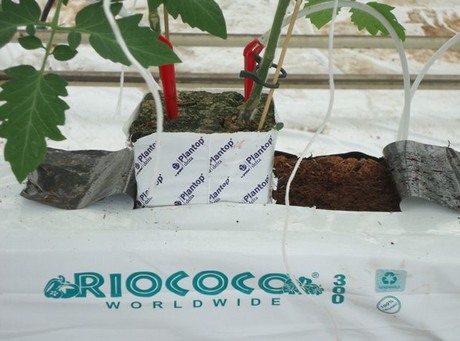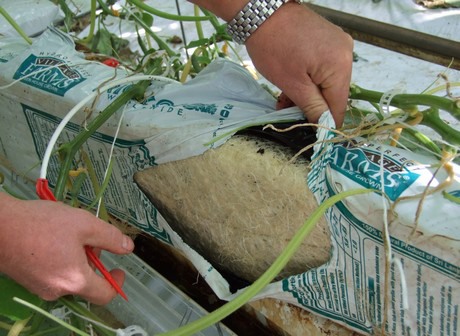
Jan Korteland
Village Farms has got several divisions in West Texas. In some of the greenhouses a new crop is already planted. "At the Fort Davis division we planted the first new crop a section of the 8 hectare greenhouse two weeks ago. The other 8 hectare will be empty and cleaned in week 32," said the locations manager who has been in charge at Village Farms in Texas for more than 15 years now. With a background in Dutch horticulture, Korteland started to work for Village Farms in 1993. In 1999 he moved to West Texas to be the grower of 16 hectares in Marfa, and later became the Regional Manager. Together with the technical growing staff, Korteland is overseeing the overall operations in West Texas.

New crop after 2.5 weeks. Picture taken on June 1.
All of the plants are being seeded, grafted and propagated in British Columbia, Canada by Houweling's. "We are aware of the fact that it is a big logistical operation, but this is the best option for us. For propagation, the climate in B.C. is far better in the summer than in West Texas. Houweling's has got the knowledge, propagation facilities and the right people to do it, hence a lot of premium growers in North America trust in their services.


New crop roots after 2.5 weeks. Picture taken on June 1.
Right now the young plants are propagated on rockwool cubes, but Village Farms has done some small experiments with the new coir propagation blocks from RIOCOCO. "We are running some small trials, however it is not yet possible to draw conclusions. It would be nice if we can eventually use both coco propagation blocks and slabs, but right now we are still using rock wool blocks," said Korteland. The reason for Village Farms to experiment with coir blocks is because they have been using Riococo slabs for more then 8 years now on a big part of their total acreage.


"Growers in the USA are really into coir growing media", said Korteland. "This has got to do with the fact that it is got an attractive price and moreover similar results as with rockwool can be achieved, unless you use the right coir mix. That’s why, when we were thinking about starting to grow on coir, we ordered a lot of samples from a lot of suppliers, just to compare the quality.”
“When you take a closer look at all of the coir that is available around the world, you will find a lot of differences amongst them. For us, RIOCOCO was one of the coir slabs that really stood out for consistency, uniformity and the right mix. Their service and further investment in knowledge, relationship and support had convinced us to start using their slabs on a small acreage and within a few years we switched to 100% RIOCOCO coir slabs.

Mini San Marzano in the greenhouses
According to Jan, pricing is still one of the reasons to grow on coir. "But despite better pricing, the coir also needs to have good quality. We are growing in an extreme climate and our crops have to run a marathon. It is very hard to maintain a quality crop and fruit in this climate, but with the right substrate, we manage to keep up. Nonetheless we also still compare crop and fruit quality with the other crops that are cultivated on rockwool. We always compare, and for us there is no reason to switch to 100% rockwool."

Campari: Grown on Riococo and one of Village Farms best sellers.
Korteland adds that an absolute surplus of coir is that it is more 'forgiving'. "When you make a small mistake with irrigating, you immediately see an effect in the crop in this climate. With coir however, you still can easily make a correction before seeing a negative result in the crop."
 Picking the right substrate is just as important as picking the right variety. "In Fort Davis we grow all specialty crops like Grapes, Roma's , Campari, and Mini San Marzano on coir" said Korteland. "In the Presidio facility we grow TOV's and Beefsteaks. When we select new varieties we are always looking for stress tolerant varieties because we are dealing with periods of high temperatures that are around 34-35 degree Celsius. This amongst the best taste, high yield and good shelf life. In the desert the crops needs to be strong, you can really compare this to running a race. And we think that the RIOCOCO slabs are the right running shoes for our crops to make it to the finish in time, with good quality and higher production.”
Picking the right substrate is just as important as picking the right variety. "In Fort Davis we grow all specialty crops like Grapes, Roma's , Campari, and Mini San Marzano on coir" said Korteland. "In the Presidio facility we grow TOV's and Beefsteaks. When we select new varieties we are always looking for stress tolerant varieties because we are dealing with periods of high temperatures that are around 34-35 degree Celsius. This amongst the best taste, high yield and good shelf life. In the desert the crops needs to be strong, you can really compare this to running a race. And we think that the RIOCOCO slabs are the right running shoes for our crops to make it to the finish in time, with good quality and higher production.”For more information about Village Farms, please visit www.villagefarms.com
 For more information on coir growing media:
For more information on coir growing media:RIOCOCO
Shan Halamba
shan@ceyhinzlink.com
www.riococo.com
